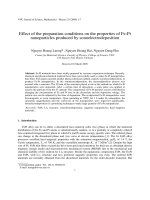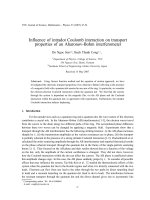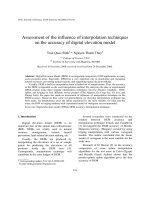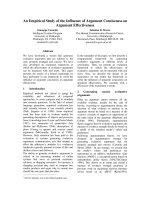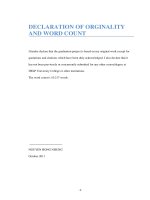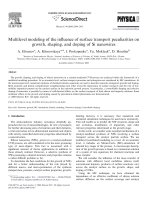Influence of intradot Coulomb interaction on transport properties of an Aharonov-Bohm interferomete
Bạn đang xem bản rút gọn của tài liệu. Xem và tải ngay bản đầy đủ của tài liệu tại đây (1.32 MB, 8 trang )
<span class='text_page_counter'>(1)</span><div class='page_container' data-page=1>
VNU Journal o f Science, M athem atics - Physics 23 (2007) 47-54
Influence of intradot Coulomb interaction on transport
properties of an Aharonov-Bohm interferometer
Do Ngoe Son1’2, Bach Thanh Cong1’*,
1<i>D epartm ent o f Physics, C ollege o f Science, VNU </i>
<i>334 Nguyen Trai, Hanoi, Vietnam </i>
<i>2 Graduate School o f Engineering, Osaka University, Japan</i>
Received 15 May 2007
A b s t r a c t. Using Greens íunction method and the equation of motion approach, we have
investigated the electronic transport properties of an Aharonov-Bohm (AB) ring in the presence
of a magnetic field with a quantum dot inserted in one arm of the ring. In particular, we consider
the electron-electron Coulomb interaction within the quantum dot. We find that the current
through the system is dependent on the magnetic flux via the AB phase and the Coulomb
interaction within the quantum dot, in agreement with experiments. Furthermore, the intradot
Coulomb interaction induces dephasing.
1. Introduction
For the nanodevices-such as a quantum ring and a quantum dot, the wave nature of the electrons
contributes a crucial role. In the Aharonov-Bohm (AB) interíerometer [1-3], the electron waves travel
from íhe source to the drain along two different paths of the ring. The accumulated phase difference
betvveen these two waves can be changed by applying a magnetic field. Experiments show that a
transport through the AB interferometer has the following striking features: (i) the AB phase increases
sharply by 7T, (ii) the transmission amplitudes at the various resonances are in phase, (iii) the transport
is partially coherent in the presence of a strong intradot Coulomb interaction [1-3]. Hackenbroich et al.
calculated the entire scattering amplitude through the AB interferometer and reported theoretical results
on the phase coherent transport through the quantum dot in the frame of the single-particle scattering
theory [3, 4]. They íịcused on the AB phase and their results showed that as a íiinction of the voltage
on the dot, only the amplitude of the current oscillations is changed. They did not show, hovvever,
how the Coulomb interaction vvithin the dot can affect the current. The AB phase is unaữected unless
this amplituđe changes sign. In this case, the AB phase suddenly jumps by <i>lĩ.</i> To consider all possible
eíĩects that may iníluence the system, Tae-Suk Kim et al. [5] studied the thenmoelectric effects of this
system when the quantum dot lies in the Kondo regime and when it is directly connected with the two
leads. Electrons can flow from One lead to the other through the tvvo paths by direct tunneling (lead
to lead) and a resonant tunneling via the quantum dot (lead to dot to lead). The interference betvveen
the resonant transport through the quantum dot and the direct channel gives rise to asymmetric line
' Corrcsponding author. Tel: 84^-8584069.
E-mail:
</div>
<span class='text_page_counter'>(2)</span><div class='page_container' data-page=2>
48 <i>Do Ngoe Son, Bach Thanh Cong / VNU Journal o f Science. Mathemaíics</i> - <i>Physics 23 (2007) 47-54</i>
shapes in the linear conductance as a íunction of gate or bias voltage, the vvell-knovvn Fano effect [
6
].In the same context, Bogdan et al. [7] and Walter Hofstetter et al. [
8
] studied the combination of theKondo effect and the Fano eíĩect.
How the intradot Coulomb interaction iníluences the phase coherence of electronic transport
through the AB interferometer has been the subject of debate. Several theoretical papers concluded
that the intradot Coulomb interaction induces partial dephasing from the spin-flip process [9-11], vvhile
others argued that the intradot Coulomb interaction does not induce dephasing effect at all and the
transport through the quantum dot is fully coherent [12-14]. We believe that this inconsistency may be
solved by using a model that considers the role of the quantum ring that connects to the quantum dot,
vvhich was ignored in the previous works (9, 14], since the typology of the ring may play an important
role in the transport property of the system. AIso, a theoretical model that more closely resembles the
experimental model needs to be utilized in order to obtain more realistic results.
2. Model and Calculation
As a first step to address these concems, we investigate in this vvork the current through a
two-terminal AB device which contains an AB ring vvith a quantum dot inserted in one of the ring’s
amis [
1
].</div>
<span class='text_page_counter'>(3)</span><div class='page_container' data-page=3>
<i>Do Ngoe Son, Bach Thanh Cong / VNU Joum al o f Science, M athem atics - Physics 23 (2007) 47-54</i> 49
vvith diíĩerent Coưlomb interactions, are in phase [1-3] and the intradot Coulomb interaction can induce
dephasing under an appropriate condition.
We can express the Hamiltonian for the present system (vvith the quantum dot as an impurity)
as íbllovvs
<i><b>H = Ho + HT + He </b></i> <b>(1)</b>
Here, <i>Ho</i> describes the totally isolated subsystems of two leads, AB ring, and quantum dot, and
is givcn explicitly by
<i>H o = </i> <i>ỵ ,</i> e*„C£,+C£, + (
2
)<i>k ơ , a = L , R </i> pơ <i>a</i>
NVhere Q stands for the left (L) and the right (R) leads, vvhile <i>k</i> and <i>£ka</i> are the Iongitudinal
\ v a v e number and the corresponding energy of the electron. The energies of the single particle states
vvithin <b>the </b>ring and within the quantum dot are <i>£p</i> and <i>Ed,</i> respectively. , C+,, <i>d+</i> (C£ơ, <i>Cpa</i>, <i>da) </i>
a r e thc creation (annihilation) operators for the electron in the lead, the ring, and the dot, respectively,
vvhile <i>ơ</i> is the spin index. The tunneling part <i>H t</i> consists of the couplings between the subsystems,
and is given by
<i>H r =</i> E <i>( w ^ c ^ c pơ</i> + M <i>+</i> E <i>{{Vp d C ^ d ơ + h. c) + ( v ; de - '* C ^ d ơ +</i> /i.c)]
<i>kpơ </i> <i>pơ </i>
<i>a = L J i</i>
(3)
vvhcre the tunneling matrix elements <b>w </b>describe the coupling betvveen the ring and the leads, vvhile
the tunneling matrix elements <i>V 1</i> (Vr) describe the coupling -between the lefl (right) side of the dot
and the ring. We attach the magnetic flux on the right hand side of the dot, hence carries a phase
faclor <i>e x p ( —i(ị>),</i> \vhere <i><ị> = 2rc<be/h</i> and $ is the magnetic flux encloscd by thc ring which is formcd
by the arms. Finally, the intradot Coulomb interaction Hamiltonian is given by,
<i>H c</i> = ơ n Tn I (4)
whcre <i>n ơ</i> is the number operator, <i>n ơ = d ị d ơ.</i> The upper arm (reference arm) current is deíined by
the íòllovving ĩormular [16],
w = I E / ((/ '-( £) ■ <i>M e ) ) * í a ^ (e)</i> ■ G y £ )l) (5)
vvhcre the Greens íunction for the reference arm is vvritten as
<i>a ỵ</i> (e) = ---* <i>l w.</i> ,, (
6
)<i>£ - £</i> y i IỊẳk i
<i>-6 P </i> <i>e - £ k a ± i ỗ</i>
<i>ka</i>
The line width of the leads is <b>r Q </b>= <i>2n</i> £ <i>Wp/*ơ WpkơS(e</i> — <i>£ka</i>) (a = <i>L, R),</i> and /a(£) is the
Fermi distribution function of the leads. Similarly, the lower arm current can be vvritten as
<i><b>ỉ u ^ r ^ n</b></i>
= I E / § rCií+r"?-) ((/l(£)-
<i><b>M c ) )</b></i>x |c'“ ,(e)-
<i><b>G °r°°,{e)ì)</b></i> (7 )</div>
<span class='text_page_counter'>(4)</span><div class='page_container' data-page=4>
50 <i>D o N g o e S o n</i>, <i>Bach Thanh C o n g / V N U J o u rn a l o f Science, M a th e m a tic s</i> - <i>P h ỵsics 2 3 (2007) 47-54</i>
In order to compute <i>Iioxuer.arm</i>* calculate the retarded and advanced Green íunctions (i.e.
and) for the ring-dot using the equations of motion method [17]. The equations of motion method
of the dot Green function gives rise to an iníìnỉte order system of higher-order Green functions. An
approximation procedure is applied to truncate the system of equations, thus producing the closed set
of equations. To do the truncation, vve approximate the Green íunctions up to the second order of
u. This truncation ensures that most of the interaction effects are captured. In this paper, we do not
consider the Kondo effect. Thus, the truncation up to the second order of u can be acceptable (if the
Kondo effect is expected to include, the higher-order truncation need to be developed).
Equations (
8
), (9), and (10) constitute the system of equations vvhich gives the relationshipamong the Greens functions of the quantum dot Gơơ/(ê), the ring-dot <i>Gpơơ'(e</i>), and the dot-leads
<i>GakJ ( e y ,</i>
<i>{ e - e d)Gơơ>(e)</i> =
<i>+</i>
<i>l- + (v £ '+ v £ e i+)Gpơơ'(e)+</i>
- - <i>T T </i> <i>^</i>
<i>C(ị </i> <i>L/ </i> <i>/ J</i> ì
2
<i>kpc7</i>
<i>k a ^ L . R ‘ ~ ' k a</i>
(
8)
<i>(e - £p)Gpơơ'(e)</i> = <i>Y ' W £ , G ĩ ơA e )</i> + + <i>V;de~ ^)G aA e )</i>
<i>ka</i>
(9)
(
10)
<i>(e - eka)Gakơơ,(e)</i>
= E
<i>W^ G P'a A e)</i>p'
Solving for <i>Gơa'(e)</i> and <i>Gpaciie),</i> with the assumption that the matrix elements <b>w </b>are inde
pendent on k, p, and <i>ơ,</i> we obtain
and
where
<i>A =</i>
<i>£ - e,</i>
and
<i>G ơ ơ ' ( e ) —</i>
<i>Gpơơ'{e)</i> —
<i>B</i>
<i>£ - ed -</i> ( V jĩ + <i>V £ ẽ * ) A </i>
<i>A B</i>
<i>e - e d - { V l;d</i> + <i>V £ é * ) A</i>
Q | 2
<i>\wa\</i>
<i>k a</i>
<i>T v ụ + v ụ * -* </i>
<i>p </i> <i>£- c’</i>
^ e - e p <i>e - e ka </i>
<i>p </i> <i>k a</i>
<i>+ (vỉd + v;de-i+)</i>
(11)
(12)
(13)
<i>+</i>
2
tt <i>ư < n ở ></i><i>e</i> - <i>£d - ư -</i> £
<i>e - e<sub>p ị-' t</sub></i>
<sub>-1 </sub>
<i>ka</i> <i>eka</i>
<i>< na ></i> is the average occupied number of the electron level in the dot given by
</div>
<span class='text_page_counter'>(5)</span><div class='page_container' data-page=5>
<i>Do Ngoe Son, Bach Thanh Cong / VNU Journal o f Science, Mathematics</i> - <i>Physics 23 (2007) 47-54</i> 51
< <i>n„ >= - - ' 2 2 [ </i> <i>d e l m G ơa,{e + iỏ)</i>
<i>n</i> w' <i>J -°°</i>
(15)
where <i>ỏ</i> is an infinitesimal quantity.
To check formulas (11) and (12), we determine the dot Greens íunction in the atomic, non-
interacting, and strongly interacting limits:
(i) In the atomic limit, where the tunneling matrix elements V go to zero, we arrive at
_ <i>Õqơ'</i> í 1 <i>- < n õ > </i> <i>< n ỡ ></i> Ị
<i>2n \ </i> <i>e - Sd </i> <i>£ - S d - Ư )</i>
<i>=</i> - <i><</i> - - + <i>}</i> (16)
<i>A tom ic</i>
(ii) In the non-interacting limit, the intradot Coulomb interaction
u
becomes zero, hence we get1
<i>ơơ</i> <b><sub>2</sub></b>
<b>tt c - </b> <b>- (v £ </b>+ <i>V £ e » ) A</i> (17)
(IM)
In the strongly interacting limit, the intradot Coulomb interactionu
progresses to iníinity,thus we obtain
1
- < <i>riã ></i><i>U-+ 0 0</i> <i>e - e d - { v £</i><b> + </b><i>V £ é+ )A</i> <b>(18)</b>
We fìnd that the expressions (16), (17), and (18) are in good agreement with the results [17, 19].
The oniy difTerence lies in the self energy since our system is diíĩerent. To determine the retarded and
advanced Greens íunctions of the ring-dot we introduce the following relationship
<i>GrpơU e ) = Gpaa.(e + iS)</i> <b>(1 9 )</b>
By substituting <i>G r^ a,</i> into (7), wc then obtain thc lower arm current expression (with an as-
sumption that the matrix elements V are independent on p, and that the dot is always kept symmetric)
as follows
<i>\ o w e r M r m</i>
Í f « v í V d ( l + C Q S 0 ) ( e p - £ d )
/ ( /<i>L\£p) </i> <i>ỉR\£p))</i> X s <i>.</i>
\2
. fr</1
I jl\i!<i>p</i> <b>[ </b><i>{ep - ed) </i>
<i>+</i>
<b> [r«f(l + </b>cosự>)]+
e r ^
<sub>1 </sub>
<i>h</i>
r 47T
<i>Vd(</i> 1 + cos <i>Ộ) U < n ỡ ></i> (<i>ep - 6d){ep - £ d ~ ư )</i>
Ị(ep - <i>ed</i>
)2
+ [rd(l + COS0
)]2] <i>(ep - e d - U ) * +</i><b> [ 4 V J ( 1 + C 0 8 ^ Ị</b>4V j ( l + COS
<i>ậ</i>
<i>) 3</i><i> Tdư<nỡ ></i>
r [(£> - <i>£d)2</i> + [rrf(i + cos
<sub>0</sub>
)]2] <i>(ep - e d - U ) * +</i><b> [ 4 V 2 ( l + c o s * ) ỵ r Ị</b>Here,
<i>rd </i>
<i>= 2ĩĩV2ỏ{e - £p)</i> andr =
<i>rL</i>
+
<i>rR.</i>
(20)
3. Discussion
</div>
<span class='text_page_counter'>(6)</span><div class='page_container' data-page=6>
52 <i>Do Ngoe Son, Bach Thanh Cong / VNU Journal o f Science, Mathematics</i> - <i>Physics 23 (2007) 47-54</i>
<i>£đ i ư</i>
<i>*</i>
<i>i</i>
s
%
<i>£ đ </i> <i>^</i>
— ... 1
N
%
♦
AB
Ring
Quantum Dot
Figure 2. Energ) diagram of the QD. The density of statcs is represented by the dashed line.
For simplicity, we introduce a symmetric model with <i>£d = - U</i> / 2 and assume that the Fermi
levels in the dot and in the ring are the same. Resonant tunneling betvveen the two leads occurs and
the current ílovvs when an energy level in the dot is aligned with the Fermi level in the ring and in the
leads. When One of the dot levels drops below the Fermi level in the ring, this level becomes occupied
and the number of electrons increases by one in the dot. In order to scan the levels in the dot over the
Fermi level, Yacoby et ai. used a plunger gate [1]. By changing the plunger gate voltage, they were
a b le to change a s vvell as u .
In the Coulomb blockade regime and for <i>V d<</i> r << <i>u</i> and <i>£p << ư ,</i> the tunneling probability
through the dot is very small, hence, the flux depending AB oscillations of the current are dominated
by the lovvest harmonics. All higher harmonics corresponding to electrons traveling two or more times
around the ríng arc suppressed. As a result, ỉt may be regarded that the Coulomb interaction in the dot
does not iníluence the upper arm current. The behavior of the total current as a íunction of the AB
phase can then be analyzed by means of the [ower arm current, which is shown in Figure 3 for three
diíĩerent values of u (i.e. 0.1 (V), 0.4 (V), and 0.6 (V))
Figure 3 shows that as u increases, the amplitude of the AB oscillation of the current dccreases.
This means that the intradot Coulomb interaction can suppress the interference. The figure also shovvs
that the AB oscillations are all in phase. We can also find these features from the approximated
expression for (20) for <i>Vd</i> < r <i>«</i> <i> ư</i> and <i>Ep «</i> <i> u .</i> ưnder these conditions, (20) can be written as
_ <i>v d{ì</i> + c o s<i>ip</i>) ^ ( 1 +COSV?)3
<i>Ư </i> <i>U3 </i> <i>*</i>
This expression shows that: (i) the AB oscillation of the current is a function o f C0S(y?, hence,
the oscillations are periodic and all the oscillations for various u values are in phase, and (ii) the
amplitude of the current is i n v e r s e l y proportional to u .
</div>
<span class='text_page_counter'>(7)</span><div class='page_container' data-page=7>
<i>Do Ngoe Son. Bach Thanh Cong / VNU Journal o f Science, Maíhemaíics</i> - <i>Physics 23 (2007) 47-54</i> 53
<i><</i>
55
pỡ
Đ
ã
o
H
<b>AB phase </b>
<i>ệ</i>
<b> [Rađian]</b>
Figure 3. The current through the system as a íunction of AB phase for u=0.1, 0.4, 0.6 V.
efifcct provides clues to understanding the electronic properties of a variety of materials where the
intcractions between electrons are particularly strong. The Kondo effect only occurs when the defects
are magnetic or when the total spin of the electron in an impurity atom is non-zero. These electrons
cocxist vvith thc itincrant electrons in the host metal (e.g. the AB ring in the AB interferometer), vvhich
bcliave like a Fermi sea. In such a Fermi sea, all the states with energies below the Fermi level are
occupied, while the higher energy states are empty. If we scan this level over the Fermi level, one
electron from the ring should jump into the dot.
4. Conclusion
ỉn conclusion, vve obtained the current expression as a function of the intradot Coulomb inter-
action and the AB phase. The AB oscillations of the current are qualitatively in good agreement with
[1, 3]. The results shovved that the intradot Coulomb interaction induces dephasing.
</div>
<span class='text_page_counter'>(8)</span><div class='page_container' data-page=8>
54 <i>Do Ngoe Son, Bach Thanh Cong / VNU Journaỉ o f Science, Mathematics</i> - <i>Physics 23 (2007) 4~-54</i>
<b>Reíerences</b>
11J A. Yacoby, M. Heiblum, D. Mahalu, Hadas Shtrikman, <i>Phys. Rev. Lett.</i> 74 (1995) 4047.
|2| R. Schusler, E. Buks, M. Heiblum, D. Mahalu, V. Umansky, Hadas Shtrikman, <i>Nature (London)</i> 385 (1997) ị 17; Yang
Jú M. lỉeiblum, D. Sprinzak, D. Mahalu. Hadas Shtrikman. <i>Science</i> 290 (2000) 779.
Ị 31 G. Hackenbroich, <i>Phys. Rep.</i> 343 (2001) 463.
|4] G. Hackenbroich, H A. \Veidenmuller, <i>Phys. Rev. Lett.</i> 76 (1996) 110.
[51 Tae-Suk K im , s . H ershíield, <i>Phys. Rev. B</i> 67 (2 0 0 3 ) 165313.
16] u. Fano, <i>Phys. Rev.</i> 124 (1961) 1866.
(7] Bogdan R. Đulka, Pioư Steíanski, <i>Phys. Rev. Lett.</i> 8 6 (2001) 5128.
(8] Walter Hoĩstctter, Jurgen Konig, Herbert Schocllcr, <i>Phys. Rev. Lett.</i> 87 (2001) 156803.
[9| H. Akera, <i>Jpn. J. Appl. Phys.</i> 38 (1999) 384.
10] R. Zilko, J. Bonca, <i>Phys. Rev. tì</i> 6 8 (2003) 085313.
111 J. Konig, Y. Gefen’ <i>Phys. Rev. B</i> 65 (2002) 045316.
12] Zhao-lan Jiang, Qing-feng Sun, x.c. Xic, Yupeng Wang, <i>Phys. Rev. LeU.</i> 93 (2004) 076802.
13] J. Konig, Y. Geĩèn, A. silva, <i>Phys. Rev. U n .</i> 94 (2005) 179701.
14] Zhao-tan Jiang, Q in g -fe n g Sun, x . c . X ie , Y upcng W ang, <i>Phys. Rev. Lêu.</i> 94 (2 0 0 5 ) 179702.
15| PAV. Andcrson, <i>Phys. Rev.</i> 124 (1961) 41.
16) A.p. Jauho, N.s. VVingreen, Y. Meir, <i>Phys. Rev. B</i> 50 (1994) 5528.
171 J. Fransson. <i>Phys. Rev. B</i> 72 (2005) 075314.
18 1 Vyacheslavs Kashchcyevs, A m n o n A harony, O ra E ntin -W o h lm a n , <i>Phys. Rev. B</i> 73 (2 0 0 6 ) 125338.
</div>
<!--links-->
